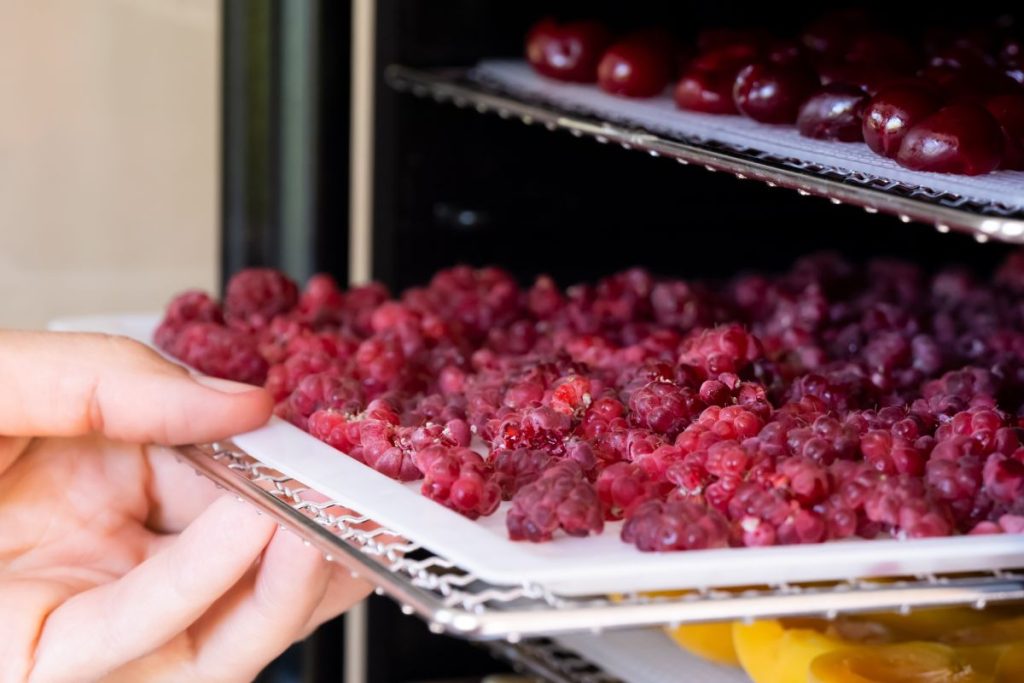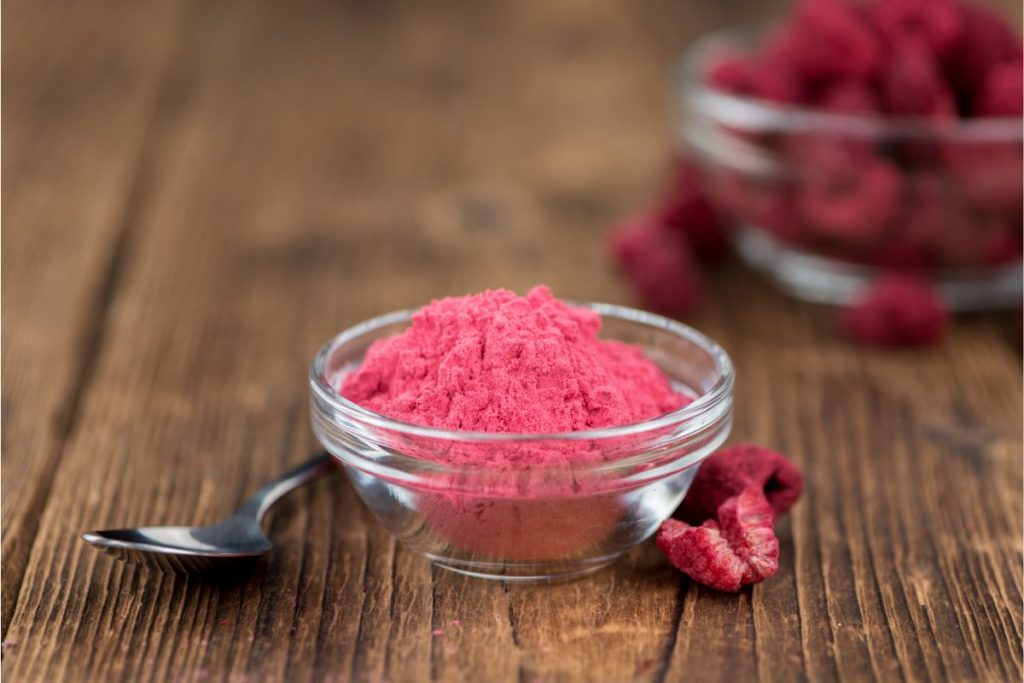To make dehydrated raspberries, wash and dry the fresh fruit before laying them out on a food dehydrator tray. Dehydrate at 135°F for 24-36 hours, checking regularly. Once fully dry, allow to cool to room temperature and store in an airtight container or grind to make raspberry powder.
Table of Contents
How to Dehydrate Raspberries in a Food Dehydrator
Dehydrating raspberries using a food dehydrator is simple and requires little prep time, making them a great option for beginners. A food dehydrator can make all sorts of dehydrated fruit, including strawberries and blueberries.
Follow these steps to make home-dried raspberries in your food dehydrator:
- First, sort through the fresh raspberries, removing any that aren’t firm or show signs of spoiling. Remove any leaves and raspberry stems.
- Wash the raspberries in cold water using a colander, and then lay the berries out on paper towels to dry. It is important you don’t start the dehydrating process until all the moisture has gone from the fruit – if they are partly wet, this will interfere with the process and increase the drying time.
- Place the raspberries on dehydrator trays in an even single layer to allow for consistent drying across the batch.
- Set your dehydrator to 135°F and place the trays inside.
- Leave for 24-36 hours, checking regularly. Every couple of hours, remove a raspberry from the batch. You’ll know they are done when they crumble and produce no moisture when squeezed.
- Once your dried fruit is ready, remove them from the dehydrator and allow them to cool to room temperature.
- Label and store dehydrated raspberries in an airtight container in a cool, dark, and dry place.

How to Dehydrate Raspberries in an Oven
If you don’t have a food dehydrator, you can make delicious dried raspberries at home using your oven:
- Inspect the raspberries, and discard any that aren’t fresh and firm.
- Rinse the fresh raspberries under cool water and pat them dry with paper towels.
- Preheat the oven to 150°F or the lowest temperature setting.
- Line a baking sheet with parchment paper, and lay the raspberries on it in a single layer, ensuring the berries do not touch each other.
- Place the baking sheet into the center of the oven. Prop open the oven door using a wooden spoon to facilitate better airflow and prevent the oven from getting too hot.
- Dehydrate the berries for 6-8 hours, checking on them regularly. Ovens have hot spots, so if you notice part of the batch drying more quickly, rotate the trays or flip the berries as necessary.
- Once the berries are fully dry, remove the tray from the oven and allow the raspberries to cool to room temperature before storing them in airtight containers.
How to Make Raspberry Powder
A great use for dehydrated raspberries is making raspberry powder. The raspberry powder can be blended into smoothies or mixed into baked goods for a rich color and a punchy flavor.
Follow these step-by-step instructions to make raspberry powder:
- Place dehydrated raspberries in a blender, food processor, or coffee grinder.
- Pulse in short intervals until they have been reduced to a fine powder.
- Run the powder through a fine mesh strainer to remove any debris or large chunks and ensure a uniform mixture.
- Use a funnel to transfer the powder into airtight shaker jars or Mason jars, and store the powder in a cool, dark, dry place.

How Long Does it Take to Dehydrate Raspberries?
It takes between 24 and 36 hours total time to dehydrate raspberries. The time will depend on the size of the raspberries, the size of the batch, the relative humidity, and dehydrating method.
Do You Need to Cook Dehydrated Raspberries?
No, you do not need to cook dehydrated raspberries. Just like fresh raspberries, they can be eaten raw.
Are Dehydrated Raspberries Good?
Yes! Dehydrated raspberries are delicious as a healthy snack and can be added to granola, cereals, or trail mix. The dehydrating process concentrates the delicious raspberry flavor into a smaller package. It’s easy to add raspberry flavor to raspberry recipes, including yogurt, ice cream, and smoothies.

What are the Benefits of Dehydrated Raspberries?
- Cheaper than buying dried raspberries from the store
- Great for on-the-go snacks and lunches
- Has a longer shelf life than fresh fruit
- Reduces waste if you have a large harvest of fresh raspberries
- Retain all the nutritional value of fresh raspberries
What Does a Dehydrated Raspberry Look Like?
Dehydrated raspberries have a slightly different color and texture than fresh raspberries. The color is more pale, becoming closer to light pink than the beautiful raspberry red of ripe raspberries. The texture of dried raspberries is brittle and hard rather than soft and plump and crumbles when pressed.

What is the Best Way to Rehydrate Dehydrated Raspberries?
The best way to rehydrate dehydrated raspberries is to place them in a covered bowl of hot water. Allow the fruit to soak for 10-15 minutes until their texture softens and they grow in size. Once you see these signs, strain the water. The rehydrated raspberries are then ready to use.
How Many Calories Are in Dehydrated Raspberries?
A quarter of a cup of dehydrated raspberries contains 125 calories. Though dried raspberries are healthy, retaining all the nutritional value of fresh berries, they also retain all the sugar content but in a smaller package. This means that by volume, a cup of dried raspberries will have more sugar than a cup of fresh raspberries.
Shelf Life and Storage of Dehydrated Raspberries
Dehydrated raspberries can last between 12 and 18 months in food storage if stored correctly. The best way to store them is in an airtight container, such as a Mason jar or Kilner jar, placed in a cool, dark area away from heat, moisture, and direct light.
Dehydrated raspberries can also be stored in the fridge or freezer to increase their shelf life. However, this can take up large amounts of space, and one of the benefits of drying fruit and vegetables is they are shelf-stable.

